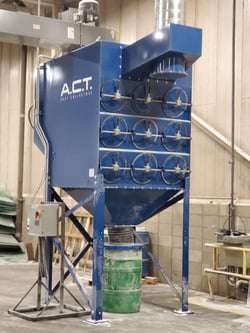 Dust collection is important no matter the industry – but one specific type of dust that requires extra attention is abrasive blasting. Properly collecting dust from abrasive blasting and sandblasting ensures health and safety for personnel and efficient operations.
Dust collection is important no matter the industry – but one specific type of dust that requires extra attention is abrasive blasting. Properly collecting dust from abrasive blasting and sandblasting ensures health and safety for personnel and efficient operations.
We’ll dive into the specifics of abrasive blasting, why it’s used, and the different industrial dust collection systems that best remove this type of particulate from the air.
What Is Abrasive Blasting and Sandblasting?
Abrasive blasting, also known as sandblasting, is the process of forcibly using pressurized air or water against a hard surface to remove coating, corrosion, or contamination.
The most common types of abrasive blasting include:
- Steel shot
- Steel grit
- Aluminum oxide
- Crushed glass
- Garnet
- Coal slag
- Ceramic grit
- Dry ice
Whichever application you’re using abrasive blasting for, it will inevitably create dust. This lingering dust is not only harmful to employees, but to efficient business practices as well.
Abrasive blasting is most often used to smooth out rough surfaces, shape surfaces, remove surface contaminants like paint, rust, or residue, power-clean surfaces, and even finish surfaces.
To achieve any of the aforementioned actions, abrasive blasters use a mechanism propelled by compressed air or a centrifugally powered wheel. In some cases, the residual media may be recycled and reused. In other cases, residue is disposed.
What Are the Dangers of Abrasive Blasting?
Because dust particles in this particular type of blasting are produced at such a high rate of speed and pressure, many dangers can ensue if not properly removed. These dangers include:
- Exposure to silica, coal slag and garnet, which can cause lung damage, inflammation and scarring
- Fire hazards
- Potential for explosion
- Oil residue
- Inhalation of toxic materials such as arsenic, beryllium, and cadmium
Aside from dust production, abrasive blasting is also very loud. It can cause substantial hearing loss to those conducting the blasting. It is recommended that every worker in a blasting environment wear appropriate ear protection equipment.
It’s important for every employer to protect their employees from the hazardous dust that is created by the blasting material as well as the surface particles being blasted.
There are a number of ways to protect your employees from the airborne particulates and other hazards of abrasive blasting. Besides providing the proper personal protective equipment (PPE) like goggles, helmets, hearing protection, and heavy-duty clothing, employers must consider a central system with the proper filter media.
Often companies find benefit in adding a dust collection system to clear the air and collect the dust from blasting processes. That’s where A.C.T. Dust Collectors comes in; we build and supply the best dust collectors in the industry. Some of our systems are in-stock for quick delivery allowing you to make a difference in your plant – without delay!
What Dust Collectors Are Best for Abrasive Blasting?
A.C.T.’s industrial dust collectors are versatile and have been installed for both wheel and air blast methods. We understand that in order to make your working environment safe, your dust collector and filtration system must operate at the highest levels.
If you’re in need of an abrasive blast dust collector, our experts can help you determine the right size and equipment you’ll need for your specific application.
Our most requested abrasive blasting dust collectors are the ACT 4-64, ACT 4-32 and the Action Booth. Here are some highlights of each dust collector:
- ACT 4-64 & ACT 4-32 – The dust source from abrasive blasting enters at the top of the main housing with inlets on the roof and optional inlets on the front for the most efficient connection. When the pulse clean system activates and accumulated dust is released from cartridges, the downward air flow through the collector assists dust fallout again. This avoids dust from re-entering the filter. The 4-64 is larger than the 4-32.
- Action Booths – This unique system combines heavy-duty construction with multifunction design in a plug-and-play package. The smooth design promotes good air flow through the booth and minimizes the chance for abrasive dust to settle outside of the airstream. The oversized inlet has vertical louvers to evenly distribute incoming contaminated air while reducing velocity for heavy material separation and therefore, lengthening the life of the filter.
Browse our selection of industrial dust collectors today, and determine which is best for your needs. Our team of experts is always available to assist you and ensure your abrasive blasting particles are being removed properly for the safety of your employees and business.
Learn more about abrasive blasting in our Case Study: Power Transformers Manufacturer Overcomes Sandblasting Challenges.


























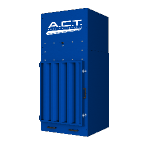
%20Collectors%20Image.png?width=143&height=143&name=ADC%20(Ambient)%20Collectors%20Image.png)
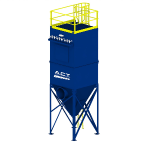

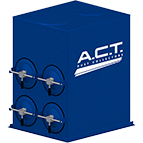
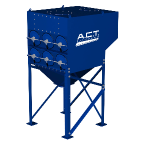
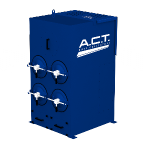


















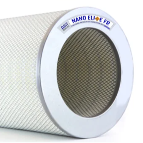


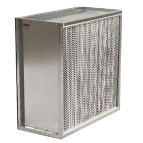
.png?width=240&height=91&name=ACT%20Dust%20Collectors%20Logo%20Solid%20White%202020%20(1).png)
.png?width=148&height=149&name=usa-manufactured-dust-collectors%20(1).png)